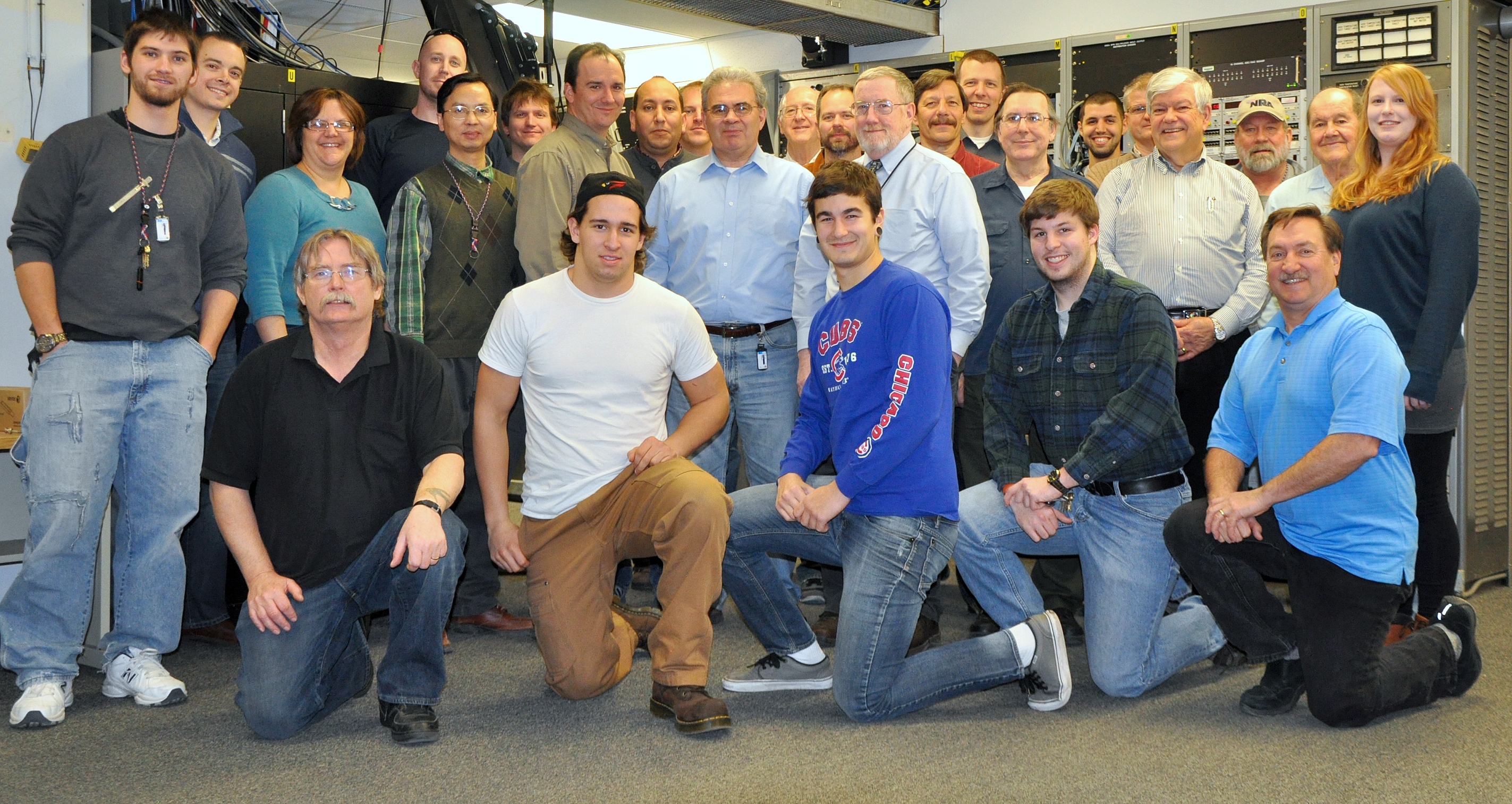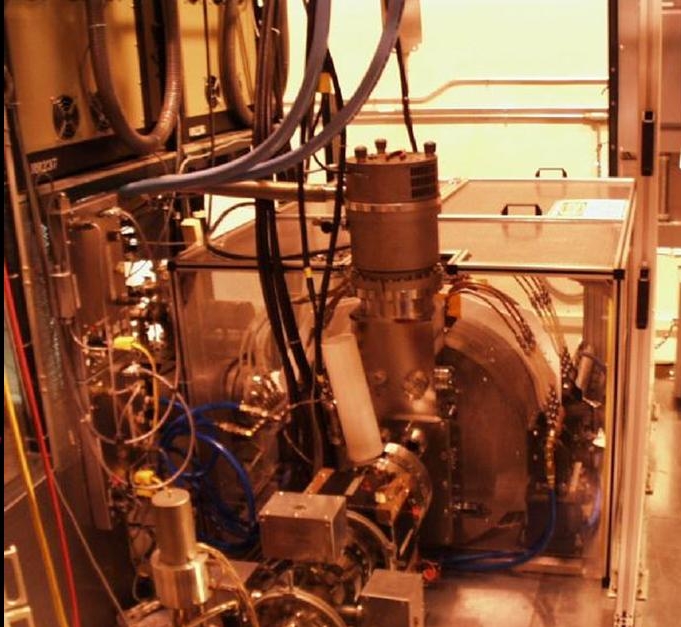The ATLAS Facility
 |
| The ATLAS Operations Group. |
ATLAS (the Argonne Tandem Linac Accelerator System) is the world's first superconducting accelerator for projectiles heavier than the electron. This unique system is a DOE National Collaborative Research Facility open to scientists from all over the world. ATLAS consists of a sequence of machines where each accelerates charged atoms and then feeds the beam into the next section for additional energy gain. The beams are provided by one of two 'injector' accelerators, either a 9 million volt (MV) electrostatic tandem Van de Graff, or a new 12-MV low-velocity linac and electron cyclotron resonance (ECR) ion source called the Positive Ion Injector. The beam from one of these injectors is sent on to the 20-MV 'booster' linac, and then finally into the 20-MV 'ATLAS' linac section. High precision heavy-ion beams ranging over all possible elements, from hydrogen to uranium, can be accelerated to energies as high as 17 MeV per nucleon and delivered to one of three target areas.
The heart of ATLAS is the superconducting split-ring resonator. The first successful test of a niobium split-ring resonator occurred in November 1977 after two and a half years of intensive development. Niobium was chosen as the superconducting surface because it is the best available superconductor for a radio-frequency device. The outer housing of each resonator is made of niobium explosively bonded to copper. The interior components of the resonator are pure niobium in which liquid helium is in direct contact for cooling. The result is an accelerating structure in which a large electric charge flows back and forth 97 million times a second between doughnut-like drift tubes. A potential difference of about 800,000 volts is generated between the tubes and can be used to accelerate a beam of any atomic nucleus. The first acceleration of an ion beam with these resonators was achieved in June 1978. A second class of resonators, known as 'quarter-wave' resonators, was developed in 1985 and 1986 as part of the Positive Ion Injector facility upgrade.
 |
| Photo showing one of the two ECR source at ATLAS. |
In a linac accelerator, ions gain energy in a manner very similar to a person riding a surfboard on an ocean wave. If the surfer goes out far from the beach, he can match his speed to an incoming wave, get on the board, and ride the wave into the beach gaining speed in synchronization with the wave's increasing velocity as it crashes into the beach. The ATLAS linac is constructed with seven different superconducting resonator designs each on creating an electromagnetic surfing wave of a different velocity. In ATLAS a total of 62 of these resonators are arranged so that particles of a given velocity are accelerated and remain synchronous, or in-phase, with the accelerating field. This array of resonators can be tuned to a wide range of effective velocities by adjusting their relative RF phases. The resonators in ATLAS are able to begin accelerating particles which have a velocity of less than 1% the velocity of light ('c') and accelerate those particles to velocities up to approximately 15% 'c'. Each of the resonators in ATLAS is relatively small and independently controlled. This unusual independent control capability of each resonator makes it possible to adjust the effective speed of the accelerating electromagnetic surf-wave through ATLAS so that any ion, regardless of mass, can be accelerated.
When a wave of electromagnetic surf goes by, the ATLAS ion source provides 1,000 to 10,000 ions in a bunch which must 'jump' on the wave for their trip through the linac. Although the ions in each bunch may start out from the same point, they are generally going in slightly different directions. Magnetic fields are used throughout ATLAS to steer these beams of charged particles and force them to go in the desired direction. In the linac these magnetic focusing fields are provided by superconducting solenoids interspersed between the resonators.
The beam from ATLAS can go into three different experimental areas which are well equipped with the instruments required for precision nuclear and atomic physics research. In the original Area II, these instruments include a 65" scattering chamber, a 30-ton magnetic spectrograph which feeds into the Canadian Penning Trap, an 18" scattering chamber, and a general purpose beam line. The experimental Areas III & IV contain similar but more advanced apparatus, including the gamma-ray facility with a bismuth germanate (BGO) scintillator array and Compton-suppressed germanium spectrometers, a large scattering chamber facility capable of supporting large area particle detectors and of providing long particle flight paths, a second large magnetic spectrograph, a 10-meter long mass separator called the Fragment Mass Analyzer (FMA), an atomic physics beam line, and two general purpose beam lines.
Since the first successful acceleration of an ion beam by the prototype ATLAS facility in 1978, ATLAS has been growing and expanding its capability to provide unique and powerful beams for the world-wide nuclear and atomic physics research program. The construction of ATLAS has continued until recently in parallel with the operation of the facility for research. As a national user facility ATLAS has provided over 55,000 hours of beam to the research community. Physicists from 94 institutions in the United States and 18 foreign countries have participated in experiments at the ATLAS during that time. The most recent improvement to ATLAS was the development of the Positive Ion Injector (PII). The PII project was completed in 1992 and allowed ATLAS to provide beams including the heaviest atoms, including uranium, with substantial increases in available beam currents of the lighter ions.
We do not expect that the development of ATLAS has come to an end. ATLAS is similar to a living organism, changing and responding to new technological challenges and research needs. Today the ATLAS staff are investigating the possibility of producing unstable (radioactive) atoms which will be accelerated by a new addition to ATLAS and then be fed into the existing ATLAS linac for studies in a wide variety of research areas. Such beams would be extremely valuable, for example, in studies of nuclear astrophysics - the field which attempts to understand the origin and abundance of the elements that make up the universe and ourselves.
![[Argonne Logo]](/images/argonne_header_logo.jpg)
![[DOE Logo]](/images/header_doe.gif)